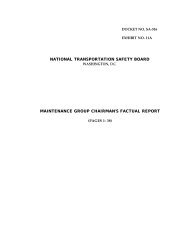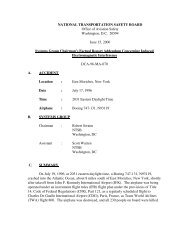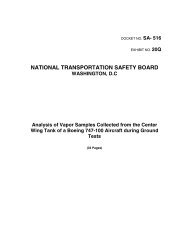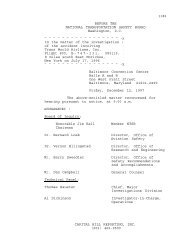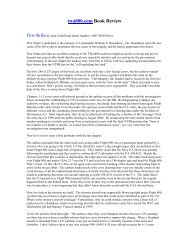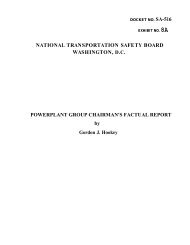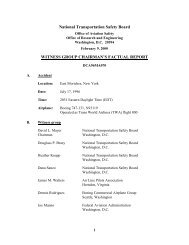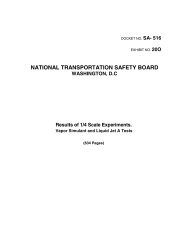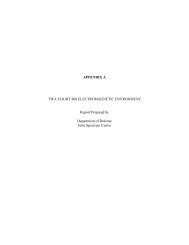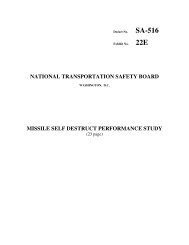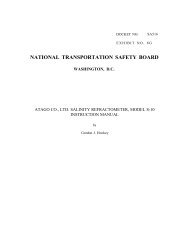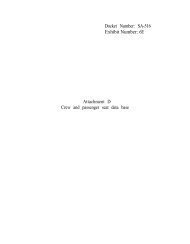Electrical Short Circuit/Arcing of Aged Aircraft Wiring
Electrical Short Circuit/Arcing of Aged Aircraft Wiring
Electrical Short Circuit/Arcing of Aged Aircraft Wiring
Create successful ePaper yourself
Turn your PDF publications into a flip-book with our unique Google optimized e-Paper software.
Test 1 & 2Wet Arc TrackingBundle: Seven wires (6 over 1) <strong>of</strong> BMS 42A/8/1-20 specification, 15 inches in length.Electrolyte: 1% saline solution @ 200 mg/minute (test 1) , 100 mg/minute (test 2)<strong>Circuit</strong> Resistance: 1 OhmGenerator: 3 phase, 400Hz, 120 line to neutral (208 line to line), 10 kVA.Length <strong>of</strong> test: 20 minutes (Test 1), 25 minutes (Test 2)Observation Test 1 Test 2Visible scintillation 00:23 00:15Flash 16:01 8:44Strong <strong>Arcing</strong> No No<strong>Circuit</strong> Breakers Tripped No NoDamage Length 1/2" 5/8"Number <strong>of</strong> Wires Failing WetDielectric Test2 <strong>of</strong> 5[C] & [B2]2 <strong>of</strong> 5[C] & [A2]The results <strong>of</strong> Test 1 and Test 2 were similar to each other though Test 2 did becomemore active a little sooner than did Test 1. Visible scintillations began within the first minute <strong>of</strong>the tests. In a couple <strong>of</strong> minutes, a char path began to develop between the two pre-damagedcracks in the insulation and scintillations were observed along this path. This is shown in Figure20.As the tests went on flashing events began to take place. At first the flashing events wereat least several seconds apart, sometimes they were up to a minute apart. Soon there were periodswhere the flash events repeated continuously, sometime several flashes per second. This wasfollowed by periods <strong>of</strong> dormancy where no electrical activity was observed. The intensity <strong>of</strong> theflash events varied both in the light and sound produced sometimes lasting several frames <strong>of</strong>video. After a series <strong>of</strong> flashes a chemical combustion flame (candle-like flame) was observedburning the insulation for a few seconds (Figure 21). The samples were each tested between 20and 25 minutes and no circuit breakers tripped.Looking at the oscillograms taken during the more active times <strong>of</strong> the test, we see thatseveral <strong>of</strong> the flashing events lasted for 5 to 10 cycles. An example <strong>of</strong> this is shown in Figure 22which shows the current in one <strong>of</strong> the three phases during Test 1. The sequence begins with 8cycle consecutive cycles having high current for at least one <strong>of</strong> the ½ cycles and some times both<strong>of</strong> the ½ cycles. This is followed by a period intermittent cycles <strong>of</strong> high current lasting for 50milliseconds followed by another 5 cycles that had continuous arcing currents. Not shown inFigure 22, but recorded on the oscilloscope, is that there were no high current cycles for the next4 seconds (corresponding to more than a 1000 cycles).<strong>Electrical</strong> <strong>Arcing</strong> <strong>of</strong> <strong>Aged</strong> <strong>Aircraft</strong> Wire.Lectromechanical Design CompanyReport No. N191-RPT4AU99 August 12, 199921



